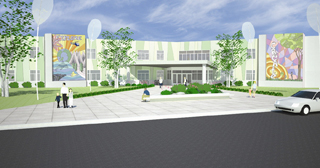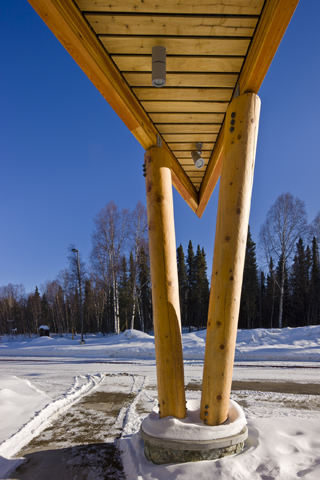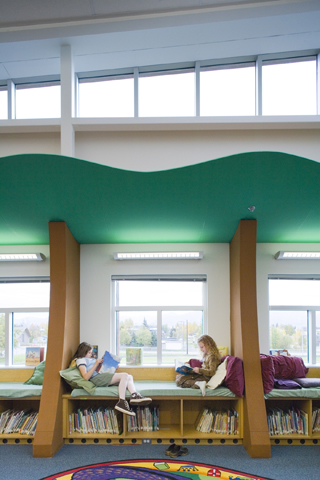|
Subscribe / Renew |
|
|
Contact Us |
|
| ► Subscribe to our Free Weekly Newsletter | |
| home | Welcome, sign in or click here to subscribe. | login |
Construction
| |
 |
July 22, 2010
Give students a say on their school design
McCool Carlson Green

Carlson
|
The bonds have passed, the architect is selected and a committee is formed to provide critical input on the needs and culture of the school.
Who is on the committee? Most of the time it’s composed exclusively of adults. Occasionally you will find an enlightened school that includes a student or two on the committee, but their participation is often marginal at best. Why is it that we are creating schools whose primary purpose is to engage and stimulate kids, but we spend so little time actually engaging them while we are creating their learning environments?
Admittedly the adults on these committees are extremely knowledgeable and committed, but can they really represent the perspective of a 5-year-old on her first day of school? For the past 20 years I have been exploring that question and searching for ways that kids’ voices can influence the design of their school.
I got started reluctantly. After being selected to renovate my neighborhood elementary school I made a casual remark that it would be neat to find out what the kids thought. I quickly forgot about the comment but the school did not. They held my feet to the fire and I soon realized that I had no idea what I was going to do with these kids.
I have to admit to a little bit of fear and intimidation as I contemplated how to engage the school in a meaningful way. Eventually we developed workshops that included every student in every grade level. It was an adventure and mistakes were made, but it was an enormously rewarding process that we have tried to repeat on every one of our school projects since.
Connecting with students
Here are some of the things I’ve learned over the years:
Renovations are absolutely the best projects to engage kids: They know their school intimately and have a personal relationship with it daily. They can tell you what works, what doesn’t, what’s cool and what sucks.
Start with playgrounds: If you are having difficulty deciding where to start, playgrounds are the slow pitch. Kids need very little prompting when you ask them to draw their dream playground. Believe me, they have ideas!
Make activities age appropriate: Ramp up the intellectual content for older kids, you’ll be amazed at the insight and sophistication of their ideas.
Get pictures: Encourage all students, even the older ones, to draw and color for you. Let them know that it’s not important that the drawings are pretty. I often show some of my rough sketches to illustrate messy work. My favorite incredulous comment was, “Someone paid you to draw that?”
Make it optional: Not all schools and all teachers have the time and interest. Don’t press too hard, you can get their input in many other ways.
Be entertaining: This may be the hardest part for us naturally dull architects but there is nothing that deflates the ego faster than to have a second-grade class lose interest. A microphone is a great prop when soliciting comments — you can pretend you are Oprah!
Don’t expect clarity: These kids are not going to reveal the meaning of life. Their input will be all over the map and you may have a hard time making sense of it. Stick with it and you will be rewarded, even if you’ll never be able to explain how.
Interpret creatively: Be open and flexible in your thinking. You have to believe there is a message or theme in there somewhere!
What to expect
What should you expect as results? Is this just a feel-good exercise? Well it can be, and there is nothing wrong with that.
Even on projects where we cannot point to the specific influence of student input in the bricks and mortar, the whole process serves to engage the entire school. It creates buy-in by teachers, and the student enthusiasm gets carried over to parents, raising awareness of school needs.
This good will can help with community relations when the voters must approve bonds. It can also create a sense of ownership that goes a long way toward reducing vandalism and crime on the school premises.
There are, however, many examples where student input has lead directly to creative design ideas that provide more engaging, meaningful learning environments. Some of my favorites are:
Painting the walls: At Polaris K-12 students had a tradition of literally painting their school with artwork, creating a strong sense of student ownership and engagement. We developed a specialized paneling system to continue that tradition that allows replacement of the panels with blank canvases in the future. This will facilitate the continuation of the tradition over the 50-year life of the school.
Tree house: Trees were important features in many of the drawings Chugach Optional Elementary kids did for us. This was an interesting development for a school site that was virtually devoid of mature landscaping. We combined this theme with window seats, providing fun places to read and reflect in the library and other places throughout the school.
Don’t be boring: Barnette Magnet School kids wanted a building that reflected the variety and excitement of their exploratory educational curriculum. The patterned, multicolored exterior features large tile panels based on student art reflecting the school’s learning signature “Explore the world/Create your future.”
Be natural: Located on the edge of the Alaskan wilderness, Su Valley Junior/Senior High kids wanted a school with soft curves and natural materials reflecting their community’s focus on art and nature. Local stone, logs and wood strips integrate with an eclectic collection of pieces by Alaskan artists. The school focal point became a dynamic community space that combined library, performance spaces and lobby functions in a curvy, light-filled entry.
The value of input
Every year the Council of Educational Facility Planners International sponsors a middle school competition that challenges students across the nation to design a school of the future.
This year’s winner, Barnette Magnet School (yes, the same school that told us not to be boring) from Fairbanks, Alaska, put together an incredible design that they presented at CEFPI’s recent Pacific Northwest Regional Conference. Their “SubZero Middle School” blew us away with the innovative and thoughtful way it integrated curriculum, schedule, sustainability, community and the learning environment while spanning the Chena River!
The level of sophistication of this proposal was truly amazing, utilizing computer tools that many architects haven’t adopted yet and building their model almost entirely from recycled materials. If you doubt the value of student input you need go no further than the School Building Week section of CEFPI’s website, CEFPI.org.
Now more than ever, our schools need to reach out and engage students. Our dropout rates are high, achievement lags and increasingly students view schools as out of touch with their lives and their futures.
Solutions to these problems are complex but I believe that making learning environments reflect student attitudes and perspectives plays a small but important role. That seems the least we can do considering we are asking them to spend a large part of their young lives in these places.
If you are an architect, be bold and find ways to engage students in your school design process. If you are a teacher, parent, administrator or community member, insist that your designers engage students in meaningful ways. The personal and professional rewards are significant and your school environments will be better for it.
Michael Carlson is a principal of McCool Carlson Green architects of Anchorage, Alaska, and president of the Pacific Northwest Region of the Council of Educational Facility Planners International.
Other Stories:
- Let a developer build your school
- School pilot project could affect county stormwater rules
- Young children need room to stretch their minds
- Putting ‘community’ into community college campuses
- Designing for early childhood education: What works?
- Why are school construction costs so low?
- Find out if your school is fit for a retrofit
- Student-centered schools put learning first
- Industry takes a leading role in new skills center
- Site headaches can be a gift for students
- Money’s tight, so how about a living building?





